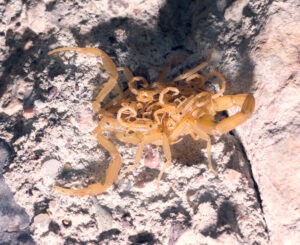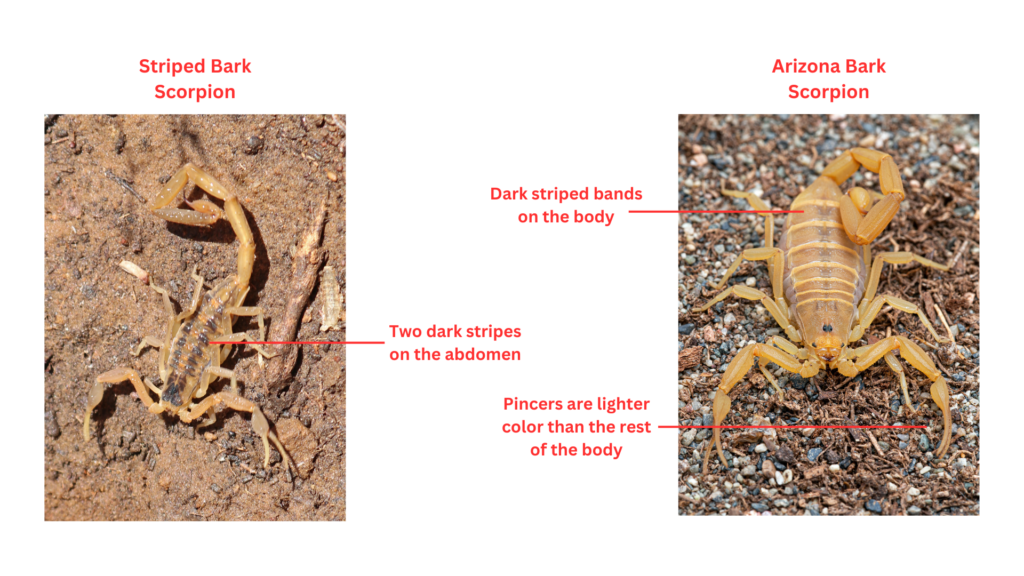If you’ve ever wandered the desert landscapes of Arizona, Nevada, or New Mexico, you’ve likely heard of the infamous Bark Scorpion. Known for their pale yellow coloring and slender bodies, these creatures are a common sight in the Southwest—but their reputation extends far beyond their size. As the most venomous scorpion in North America, the Bark Scorpion has become a fascinating yet fearsome symbol of desert life.
This guide will uncover everything you need to know about Bark Scorpions, including where they live, how to identify their sting, and the differentiation between Arizona and Striped Bark Scorpions. Whether you’re a local or are curious about these stinging insects, understanding these scorpions can help you prevent them from entering your property and ensure you know how to handle an encounter safely. Keep reading to learn everything you need to know about Bark Scorpions.
Bark Scorpion Appearance & Life Cycle

The Arizona Bark Scorpion is easily distinguishable by the following indicators:
- Size: Arizona Bark Scorpions are usually about 1–3 inches long, smaller than other scorpion species.
- Color: Light tan to brownish yellow, with dark striped bands across their body.
- Pincers: Unlike other scorpions’ thick, lobster-like pedipalps, bark scorpions’ pincers are elongated, thin, and lighter than the rest of their body.
- Tail: Slender, yellow to light tan with 5 segments, each longer than the previous. At the tip of their tail is the stinger.
Bark Scorpions often live at least 2–6 years, although they could live longer. These pests prey on smaller or medium-sized animals like beetles, crickets, roaches, spiders, insects, or even scorpions. Birds, reptiles, and other large animals eat Bark Scorpions. They often prefer to live in cooler, humid, hidden areas such as crevices, under rocks or houses, or where other smaller insects congregate.
Arizona Bark Scorpion vs. Striped Bark Scorpion

While they’re related, live in the same areas, and have a similar life cycle, Striped Bark Scorpions and Arizona Bark Scorpions do have their distinctions, including:
- Appearance: The Striped Bark Scorpion has two dark stripes on its abdomen, a thicker tail, and larger pinchers than the Arizona Bark Scorpion, making it easy to differentiate them.
- Size: Striped Bark Scorpions are smaller than Arizona ones, rarely growing over 1.6 inches long.
- Venom: One of the key differences between a Striped and Arizona Bark Scorpion is their venom. While Striped Bark Scorpions carry a painful punch with effects that can last up to several hours, the consequences of their venom aren’t nearly as dangerous as the Arizona Bark Scorpion, which we’ll explore further below.
The Arizona and Striped Bark Scorpion are attracted to warm desert-like climates, so they’re primarily found in the Southwestern United States.
Bark Scorpion Habitat
Bark Scorpions often live in Arizona, Nevada, Southern Utah, and Southwestern New Mexico. They’ll usually seek shelter under rocks, boards, or debris. However, with the hot temperatures of the Southern United States, these pests normally try to find a cool place to call home inside air-conditioned properties.
When traveling, Bark Scorpions are natural climbers, quickly scaling vertical walls or large trees as they hunt or seek a new shelter. Once inside your home, these pests will try to navigate toward dark, moist spaces like closets, sinks, or bathtubs. Basements also provide a quiet space for them to lurk in the shadows.
Bark Scorpion Stings

Bark Scorpions generally tend to stay away from humans, typically avoiding confrontation. However, they will sting if they feel threatened or disturbed. The most sure way to identify a Bark Scorpion sting is to see the scorpion sting you or another victim. Bark Scorpion sting sites often look similar to a spider bite or bee sting, with a red bump forming and mild swelling. The primary difference is that a scorpion sting is frequently accompanied by pain or many symptoms. Both Arizona Bark Scorpion and Striped Bark Scorpion stings can be painful, but their level of danger varies significantly.
Striped Bark Scorpion stings hurt, but the venom is a mild neurotoxin.
Being stung by a striped bark scorpion isn’t a pleasant experience, but it’s not as dangerous as earning one from the Arizona Bark Scorpion. Striped Bark Scorpion stings feel like a bad wasp sting, and symptoms from their venom can last a few hours.
Here are the symptoms you could experience if stung by a Striped Bark Scorpion:
- Immediate sharp pain similar to a bee sting
- Swelling and itching in the affected area can last up to several days
- There is a tingling sensation near the sting
- Redness around the sting site may appear after a few hours
If you’ve been stung by a Striped Bark Scorpion, here’s how to properly treat the sting:
- Wash the affected area with soap and water, gently scrubbing the sting site.
- Apply an ice pack or ice wrapped in a cloth to the area for up to 20 minutes.
- Take Tylenol or Advil as needed.
Striped Bark Scorpion stings are usually painful but harmless. The symptoms often go away after 24 hours, while tingling and swelling could last up to 2–3 days.
Arizona Bark Scorpion stings are extremely painful and can be potentially life-threatening.
The Arizona Bark Scorpion is the most venomous scorpion in North America. When stung by them, you could experience intense pain, and their venom can cause numbness, tingling, vomiting, and shortness of breath that generally lasts 1–3 days. Additionally, the Arizona Bark Scorpion’s sting often results in temporary dysfunction of the affected area, including symptoms like convulsions and numbness.
When stung by an Arizona Bark Scorpion, it’s known to feel like an electric shock. For kids in particular, Arizona Bark Scorpion stings are a serious threat. You might notice children constantly rubbing their noses or faces. Children may experience excessive salivation or jittery eye movement in more severe cases. Suppose you’ve encountered an Arizona Bark Scorpion and fallen trap to their sting. In that case, it’s recommended that patients visit the hospital and receive an FDA-approved antivenom, which can significantly shorten the intensity of symptoms.
Here’s what you should do if you’ve been stung by an Arizona Bark Scorpion:
- Clean the sting site with soap and water immediately.
- Apply a cold cloth or ice pack to the affected area.
- Take acetaminophen to reduce swelling.
- Seek local medical attention or call the Poison Center at 1-800-222-1222, especially if the victim is a child or senior adult.
The best way to prevent Bark Scorpions from stinging you is to stop them from coming into your home or business in the first place. Hiring a professional scorpion extermination team can ensure peace of mind and scorpion-free living year-round.
3 FAQs About Bark Scorpions?
1. What do you do if you find a Bark Scorpion in your house?
If you find a Bark Scorpion in your home, you can try vacuuming it up or trapping it under a glass container. Don’t hit it with a fly swatter or shoe, as that can make it agitated and put you at risk of being stung. While you can try these methods to eliminate a Bark Scorpion, the best solution is to call the professionals. They know what they’re doing, have the equipment to eliminate scorpions safely, and will ensure preventative maintenance to keep your home free of these pests.
2. Will Bark Scorpions crawl into your bed?
Bark Scorpions could crawl into your bed if you let blankets, covers, or sheets pool around your floor, leaving room for them to find a hidden space to call home. They’re often attracted to bedding since it provides a cool, dark shelter to hide in. Keep your bedding off the floor and your bed away from the wall, and constantly check for these creepy crawlers before climbing in for the night.
3. Are Bark Scorpion stings fatal to dogs?
Arizona Bark Scorpion stings can be fatal to dogs, especially small ones. Dogs may experience excessive itching or lick at the sting site, coughing, drooling, redness at the affected area, shaking, vomiting, diarrhea, or watery eyes. If your furry friend has fallen victim to an Arizona Bark Scorpion, or if you suspect they have, immediately take them to the emergency vet.
Prevent Bark Scorpions From Invading Your Property With Preventive Pest Control
Don’t risk a painful Bark Scorpion sting. With the help of a professional scorpion control team, you can ensure your property stays scorpion-free all year. Preventive Pest Control is a top-rated extermination company in Southern Nevada. We serve Clark County cities, including Las Vegas, Henderson, and Pahrump, and we provide locals with top-rated residential and commercial scorpion control solutions. Whether you’ve spotted a Bark Scorpion in your closet or want to take preventative measures, we’ve got your back. Our Las Vegas-based team is ready to travel to your place to provide proven expertise and scorpion elimination strategies. Call our team for 5-star scorpion control services in Southern Nevada.
